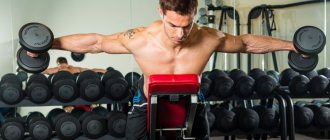What is a cool down
This is a term used to describe gentle exercises performed at the end of a workout to allow the body to gradually transition from an excited state to a calm or near-calm state.
As a cool-down, you can use slow running, which gradually turns into walking, as well as stretching.
Cooling down helps remove accumulated lactic acid, which can cause cramping and stiffness. Cooling down allows you to gradually lower your heart rate, bringing your heart back to normal. However, contrary to popular belief, cooling down does not reduce long-term muscle soreness.
After exercise, peripheral veins, especially those within the muscles, are dilated to maintain adequate blood supply to the muscles. Skeletal muscle acts as a pump, helping to return blood to the heart and keep it pumping.
A sudden stop in physical activity can cause more of the blood to remain in the veins of the muscles, thus forcing the heart to increase its rate and workload to maintain blood flow to the organs.
Calming exercises or cool down
Cooling down (or Calming exercises) allows you to prevent this condition, since during its implementation the tone of the intramuscular veins returns to normal, and the heart will not experience overload at the end of the workout.
The duration of a cool-down in bodybuilding is on average 5-10 minutes.
This is a series of gentle aerobic exercises used as stretches to complete the workout. These exercises help gradually reduce the load on the heart.
Simple cool-down exercises
Let's look at 5 simple warm-up exercises that will help warm up your body before training:
Stretch the neck muscles to the sides
Place one hand on the top of your head and extend the other along your body. Tilt your head to the side and make a slight effort with your hand on the top of your head. Don't pull your shoulders up. Hold the tilt at the maximum point for a few seconds. Repeat with an incline to the other side.
Stretch the neck muscles to the sides
Delt stretching
Stand straight with your feet shoulder-width apart. Extend your arm in front of you and clasp your forearm at the elbow. Press your hand to your body and hold for a few seconds at the extreme point. Do the exercise for both hands.
Delt stretching
Standing triceps stretch
Stand up straight, bend one arm at the elbow and place it behind your head. With your other hand, grab the elbow of your bent arm and apply a little pressure. Do not make sudden movements; there should be a feeling of slight stretching. Stay at the extreme point for 10-20 seconds. Switch hands.
Standing triceps stretch
Dynamic stretching of the back muscles
Stand straight with your feet shoulder-width apart. Swing both arms at the same time in front of you. Increase the amplitude each time until your arms rise above your head. Repeat 10 times. Do not jerk at the extreme point.
Dynamic stretching of the back muscles
Latissimus dorsi stretch with emphasis on the wall
Stand facing a wall at a wide stride distance. Bend your elbow and rest your forearm on the wall above your head. Slowly tilt your torso toward your arm, stretching your back muscles.
Latissimus dorsi stretch with emphasis on the wall
Swing your leg forward and backward
Stand next to a support, a chair or a wall will do, hold on to it with your hand. Swing one arm forward, keeping your leg straight, then swing back. Raising your leg, your back remains straight. Return to the starting position. Do 10-20 swings with each leg.
Swing your leg forward and backward
Quadriceps stretch with roller
Lie face down on the floor. Support your body weight on your palms or forearms. Place the bolster under your right thigh. Lift your foot off the floor. Relax your leg as much as possible. Roll forward on the roller. Support your body weight on your arms. Stay in this position for 10-30 seconds. Switch legs.
Quadriceps stretch lying face down on the floor using a bolster
Hamstring stretch on a roller
Sit on the floor and straighten your legs. Place the bolster under the upper thigh of your right leg. Leaning on your hands, lift your hips off the floor and transfer your body weight to the leg with the roller. Relax the thigh and shin of your working leg. Roll your foot along the roller from the top of your thigh to your knee. Switch legs.
Hamstring stretch on a roller
This set of exercises will not take much time and will perfectly prepare the body for training. These 5 exercises can be included after your workout.
Forums
Training scheme:>
If yesterday you easily completed all the circles without violating any of the 3 MAIN RULES, then today add repetitions to each circle: +1 pull-ups, +2 squats, +2 push-ups, +2 squats. Thus, each of your circles will look like: 2-4-4-4. Also don’t forget about the x2
, if you can't add full reps and your current round rep count is less than 5-10-10-10.
Warm-up
We know how lazy you may be to warm up and how you want to quickly start your main workout. But believe me, if you plan to exercise without injury, then warming up is a MUST
part of any workout. And in today's info post we will explain why:
What's good about warming up?:>
1. It prepares your cardiovascular system for the upcoming workout.
2. It prevents premature production of lactic acid. 3. It increases the temperature of muscles, ligaments and connective tissues and reduces the likelihood of injury. 4. It makes muscles faster, more agile and stronger. 5. It allows you to diagnose problems or individual limitations at an early stage of training. 6. It gets your mind ready for your workout. The main principle of warm-up
Warm-up should be targeted! This means that you should stretch and warm up the parts of your body that will be under stress. Of course, jogging and squats or jumping rope before doing pull-ups on the horizontal bars is also a warm-up, because it increases body temperature, prepares the systems for training, etc., but this is a general warm-up. Afterwards, it would be a good idea to stretch all the joints, ligaments and muscles that will be used during pull-ups (back, arms, neck, shoulders, etc.).
The more difficult the workout ahead, the more attention you need to pay to warming up and preparing for it!
What should be the intensity of the warm-up?
It is recommended to give a load that would accelerate the pulse to 90-120 beats per minute, but would feel moderate. Your main task during the warm-up is to “warm up” your body and prepare it for the load. Very often, the moment when sweat appears is used as an indicator of “warm-up”, but here everything can also depend on the conditions in which you train.
What should be the duration of the load?
The duration of the load, as mentioned earlier, depends on the complexity of the upcoming workout. Therefore, you need to focus not on time, but on sensations. After warming up, you should be in full combat readiness!
Typically, the warm-up takes 3-5 minutes before light workouts and 10-15 before heavy workouts or if there are any indications for increasing the duration of the warm-up.
What warm-up options are there?
In fact, there are a huge number of ways to warm up before training, so over time, each of you will be able to choose the one that suits you best. Well, as part of the 100-day workout, our main task is to introduce you to various warm-up options.
1. Joint gymnastics
Here is one similar warm-up complex from Maxim Trukhonovets
:
Show spoiler
1. Neck: 1.1 Bend forward and backward - 10 times back and forth. 1.2 Turns left and right - 10 times back and forth. 1.3 Rotations (circular movements) left and right - also 10 each. 2. Shoulders: 2.1 Shoulder lifts up - 30 times. 2.2 Circular movements forward - 30 times. 2.3 Circular movements back - 30 times. 2.4 Multidirectional circular movements - 15 times in each direction (alternating, of course). 3. Elbows. 3.1 Arms extended to the sides. We make circular movements in and out 30 times each. 3.2 The same thing, but hands in front of you. Simultaneously forward, simultaneously backward - also 30 times. 4. Hands. 4.1 The same as the elbows, 20 times each. 4.2 Hands in the lock. Circular movements. 20 times. 4.3 Then pull the hands by the palms outward and the fists inward. 5. Arms to the sides, palms down, back straight. Tilt your head to the right and at the same time turn your left palm up (clockwise movement). The same thing only with tilting the head to the left and turning the right palm counterclockwise. Important: the entire arm is rotated up to the shoulder. If the spine in the thoracic region crunches, then it’s normal. 6. One hand up, the other down. Feet shoulder width apart. We do it back twice with straight arms, on the count of three we change hands and also back twice. So 20 repetitions. 7. Arms parallel to the ground, elbows bent at the chest. On the count of one or two, we make backward movements with bent arms (an attempt to bring the elbows together behind the back). On the count of three or four, we turn to the left and spread our arms (an attempt to bring our arms straight behind our back). Then again the starting position. Then to the right. And so on for 20 circles. 8. Circular movement of the upper body (as if with a shoulder girdle). The belt is motionless. Left and right 10-15 times. 9. Tilts left and right. To the left - the left hand is raised up, the right hand is on the belt. To the right is the opposite. 10-15 tilts in each direction. 10. Circular movements with the body of the arm in front of you, bent at the elbows, can be pressed to the chest (here the shoulder girdle does not rotate, and rotation is ensured by the abdominal muscles). 10-15 times in each direction. 11. Circular movements of the pelvis (hands on the belt). 10-15 times in each direction. 12. Standing at a support, make circular movements with the left (right) leg bent at the knee and abducted to the side. 10-15 times back and forth, respectively. 13. Standing on one leg (you can have a support), pull your left (right) leg by the knee to your chest with your hands. from 2 to 5 times on each leg. 14. Standing on one leg (you can have a support), pull your left (right) leg (foot) to your butt with your hand. from 2 to 5 times on each leg. 15. Feet together, knees slightly bent, palms on knees. Circular movements of the knees to the left (right) 20 times in each direction. 16. Feet slightly wider than shoulder width, knees slightly bent, palms on knees. Circular movements of the knees inward (outward) 20 times in each direction. 17. Feet shoulder width apart. Circular movement of the foot of the right (left) leg (the main emphasis is on the opposite one, respectively). 10-20 times on each leg. 18. Tilts. Starting: hands on the belt, legs shoulder-width apart, straight. On the count of one - bend to the left leg, on the count of two to the center, on the count of three to the right leg, on the count of four return to the starting position. So 10-15 laps. 19. Lifting on your toes (calf exercise). I do 10 lifts for each leg separately. You can do it together if it’s difficult. It is also possible at the support. Then incomplete squats in the amount of 15 pieces. All exercises are performed at an average or slow pace. Maximum 15 minutes for everything about everything.
And a similar warm-up for girls from Anastasia Pirogova:
2. Imitating warm-up
If you plan to train with weights and iron, then as a warm-up it will be useful to perform all the same exercises, but using your own weight, that is, in a lighter mode. Likewise, if your workout is based on bodyweight exercises, then you can use lighter versions of them as a warm-up. For example, Australian pull-ups before regular ones or push-ups before dips.
3. Shadowboxing
The third good way to warm up is the so-called “shadow boxing” (which they loved to show as training for the main character of action films of the 90s). One of the main advantages of this warm-up option is variety (thanks to the ability to improvise in the process) and inclusion of the whole body in the work, and not just its individual parts.
Hitch
Remember: even when you've completed your last rep on the very last round, the workout isn't over!
It would seem that you have warmed up well, trained hard and now you can lie down on the couch with a clear conscience, but in fact you need to do something more. You need to do a short cool-down to calm the body and return it from an excited training state to a resting state.
Cooling down is very important because it allows you to make the return process smooth, avoiding the stress on the body that can occur during a sudden transition from vigorous activity to a state of rest. But sometimes such sudden transitions cause dizziness, weakness and even fainting!
Why is it important to cool down?
1. It helps normalize the functioning of the cardiovascular system by relaxing working muscles. 2. It normalizes the level of adrenaline in the blood and blood pressure. 3. It prevents possible negative consequences of the transition from the active mode to the resting state.
Cool down duration
We would recommend that you always go by your own feelings. The main thing is that the pulse and breathing return to a calm rhythm. Typically the cool-down duration is 5-10 minutes.
Cool down intensity
This parameter is directly related to the intensity of the previous workout. Your main task is to smoothly transition from training to cool-down, and from cool-down to rest. Thus, throughout the cool-down, the intensity should gradually decrease, and along with it, your heart rate will decrease.
Approximate hitch
As an example of a cool-down, we present to your attention a video from Dmitry Smirnov, fitness editor of the Russian edition of Men's Health magazine:
In conclusion, it should be added that there are different types of cool-downs. Depending on your condition, you can simply stretch quietly, or you can do a couple of exercises from your main workout, doing them at a lower intensity or in easier variations.
100-day workout - Contents
What will happen tomorrow?
And tomorrow we will look in detail at the first of the basic exercises in our program - pull-ups. We'll tell you all about the safe and effective technique of execution, and pay attention to the common mistakes of beginners.
Cool down with an app
We downloaded a special application and are ready to tell you about the importance of warm-up and cool-down in this review. Any experienced athlete knows for sure that you cannot immediately start working on your body without preparation. Likewise, after active exercise, you should not leave your body in a maximally tense state.
The Bodymaster team tested a simple, free and effective Exercises app for warming up and cooling down , which you can do.
If you are new to sports, at first you will be confused about the concepts of “warm-up”, “cool-down” and “stretching”. Remember that these are different types of exercises that need to be performed during a certain period of training.
- Warm-up is a set of exercises to warm up muscles and joints. You prepare your body for strength loads, improve concentration and perception. On average, warming up before exercise should take about 10-15 minutes.
- Cool down is a restorative exercise that helps to even out muscle tone, regulate pulse, blood pressure and body temperature. For this type of exercise, in particular, exercises with a foam roller are suitable (link to review). Experts recommend taking about 5-10 minutes to cool down.
- Stretching is also recommended after training. This complex helps trained muscles return to their original size to build new mass.
You can watch a more detailed review in our video:
What is myofascial release
Myofascial release is becoming increasingly popular. This is a special massage technique using a roller or balls that works on the muscles and fascia (the connective tissue that surrounds the muscles) to relax. The technique helps relieve the discomfort of muscle stiffness, eliminate tension and pain, improve blood flow and lymph flow. For it, a special roller or dense balls of different sizes are used, influencing trigger points and zones until noticeable relaxation is achieved. You need to perform a massage for literally 5-7 minutes.
This type of self-massage is not difficult to master. But this will help your body recover faster and better after training.
Why do you need a cool down and warm up?
- By warming up before a workout, you don't just warm up your muscles, preparing them for stress. Qualitative changes occur in almost all vital systems of the body:
- The heart rate increases, blood flow increases, and the muscles are better supplied with nutrients.
- Blood pressure increases, also providing rich blood flow to the muscles.
- Muscles become more resilient. Reduces the risk of injury.
- Due to rapid breathing, ventilation of the lungs increases, the body stores oxygen for future use.
- Due to improved neuromuscular communication, the body requires less energy. Consequently, the central nervous system is less overloaded.
- Body temperature rises to 38.5 - 39 degrees Celsius. Due to this, physiological reactions occur more efficiently. In addition, ligaments and tendons become more flexible and elastic.
- The body produces more joint fluid, increasing the volume of articular cartilage. Because of this, it is easier to bear pressure during training.
- Warming up increases concentration and perception to overcome obstacles. It is easier for an athlete to motivate himself to work with his body, and the positive attitude toward results increases.
Experts also recommend following simple but essential warm-up rules:
- Body temperature must be increased gradually, without sudden jumps.
- When warming up, take into account the weather, time of day, age and experience of the athlete.
- Warm-up duration is from 10 to 15 minutes.
- Between warm-up and training, no more than 5 minutes should pass, since after this the saturation of the muscles with blood begins to decrease.
Why do you need a cool down after training?
Cooling down restores the body, exhausted by intense exercise. So, after a quick climb from the first to the fifth floor, you are unlikely to be able to do any hard work: you need to catch your breath and relax your muscles.
The same principle applies to sports training. Without effective rest, it will be much more difficult for you to start new exercises, including exercise machines.
Effects of a quality cool down:
- Muscle tension decreases;
- Pulse, body temperature, blood pressure are equalized;
- Restores the central nervous system
- Lactic acid is removed from the body, which causes you to feel a burning sensation in your muscles.
As with the warm-up, it is important to follow the rules during the cool-down:
- Cool-down exercises should not last more than 10 minutes;
- Monitor your pulse - it should not rise above 120 beats per minute.
For a cool-down, an exercise bike, treadmill, or foam roller are ideal for rolling tense muscles. After the cool-down, you can spend some time in the bathhouse or sauna, and also have a massage session.
How to cool down?
It is easier to cool down according to the rules than to warm up properly before training. The intensity and duration are approximately the same as the warm-up, but if you are very tired, you can shorten the cool-down - just walk at a fast pace to restore your heart rate, and then do a few stretching exercises. If the load was not prohibitive, then it is better to end the workout with a light cardio load, and then stretch the muscles - aerobic exercise will restore the pulse, stretching will relieve tension from the muscles.
Warm up and cool down. Exercises in the app
The training course in the application follows a familiar and well-developed scheme. On the main screen, all exercises are collected into two complexes:
- Warm Up (set of exercises for warming up)
- Cool down (cool down after exercise)
You set the time during which you will perform the activities. Based on this time, the application will put together a set of exercises for you. In preview mode, you can see what the mobile program has prepared for you, and also put all the exercises in random order.
The training takes place in the format of visual lessons. The model in the video shows the technique, and the voice instructor gives commands to get ready, start, change sides and finish.
Once you've completed the exercises, your workout is marked on the calendar. So you can see on what day and for how many minutes you worked out and how many calories you burned.
All exercises for warming up before training and cooling down after it are collected in a separate list. Here, each exercise is provided with a visual video card.
If you purchased the premium version for 119 rubles, you are given access to individual training. You set the duration of the workout, the frequency and duration of rest, and make yourself a list of exercises.
We also recommend setting up notifications for yourself so that you don’t forget to complete the appropriate exercises.
The application does not contain any detailed and visual reporting; there are no graphs or tables of your workouts. The maximum you can personalize is height and weight data.
However, complex reporting is not particularly needed here. Warm-up and cool-down application. The exercises are purely practical in nature so that your workout brings the most beneficial results.











